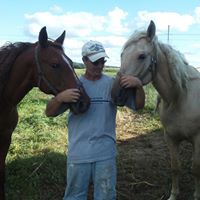Terry E Graber
age ~63
from Hillsborough, NJ
- Also known as:
-
- Terry Ellis Maura Graber
- Eric Graber
- Terrye Graber
- Charalambos Pasagelis
- Phone and address:
-
12 Raddel Ct, Millstone, NJ 08844
9089041565
Terry Graber Phones & Addresses
- 12 Raddel Ct, Hillsborough, NJ 08844 • 9089041565 • 9089041951
- 108 Brookhollow Dr, Downingtown, PA 19335 • 6102695910
- Newtown, PA
- New York, NY
- Roslyn, NY
- Yardley, PA
- Bensalem, PA
- Somerset, NJ
Medicine Doctors

Terry M. Graber
view sourceSpecialties:
Family Medicine
Work:
Regional Health PhysiciansCuster Clinic
1041 Montgomery St, Custer, SD 57730
6056739460 (phone), 6056733917 (fax)
Regional Health PhysiciansHill City Regional Medical Clinic
238 Elm St, Hill City, SD 57745
6055744470 (phone)
Regional Health PhysiciansHill City Clinic
238 Elm St, Hill City, SD 57745
6055744470 (phone)
1041 Montgomery St, Custer, SD 57730
6056739460 (phone), 6056733917 (fax)
Regional Health PhysiciansHill City Regional Medical Clinic
238 Elm St, Hill City, SD 57745
6055744470 (phone)
Regional Health PhysiciansHill City Clinic
238 Elm St, Hill City, SD 57745
6055744470 (phone)
Education:
Medical School
University of Illinois, Chicago College of Medicine
Graduated: 1987
University of Illinois, Chicago College of Medicine
Graduated: 1987
Procedures:
Vaccine Administration
Wound Care
Wound Care
Conditions:
Acute Bronchitis
Acute Pharyngitis
Acute Sinusitis
Allergic Rhinitis
Anxiety Phobic Disorders
Acute Pharyngitis
Acute Sinusitis
Allergic Rhinitis
Anxiety Phobic Disorders
Languages:
English
Spanish
Spanish
Description:
Dr. Graber graduated from the University of Illinois, Chicago College of Medicine in 1987. He works in Hill City, SD and 2 other locations and specializes in Family Medicine. Dr. Graber is affiliated with Custer Regional Hospital and Rapid City Regional Hospital.
Us Patents
-
Method And Apparatus For Attaching Navigational History Information To Universal Resource Locator Links On A World Wide Web Page
view source -
US Patent:57129797, Jan 27, 1998
-
Filed:Sep 20, 1995
-
Appl. No.:8/531031
-
Inventors:Terry E. Graber - Downingtown PA
Joshua Kopelman - Malvern PA
Edwin Howell Watkeys - North Wales PA
Marvin I. Weinberger - Havertown PA -
Assignee:Infonautics Corporation - Wayne PA
-
International Classification:G06F 1130
-
US Classification:39520011
-
Abstract:A method and apparatus for tracking the navigation path of a user that has been directed to a second site on the WWW from a first site on the WWW. A URL is received at the second WWW site when the user is directed from the first site to the second site. At the second WWW site, information representative of an identity of the first WWW site is captured by identifying a first code in the URL. A destination web page is determined for the user, and a revised destination web page is formed by attaching a second code representative of the identity of the first WWW site into at least one selected web page link associated with the destination web page. The revised destination web page is then transmitted to the user.
-
Method And Apparatus For Tracking The Navigation Path Of A User On The World Wide Web
view source -
US Patent:57178607, Feb 10, 1998
-
Filed:Sep 20, 1995
-
Appl. No.:8/531370
-
Inventors:Terry E. Graber - Downingtown PA
Joshua Kopelman - Malvern PA
Edwin Howell Watkeys - North Wales PA
Marvin I. Weinberger - Havertown PA -
Assignee:Infonautics Corporation - Wayne PA
-
International Classification:G06F 1314
G06F 1342
H04L 1246
H04L 2902 -
US Classification:39520012
-
Abstract:A method and apparatus for tracking the navigation path of a user that has been directed to a second site on the World Wide Web (WWW) from a first site on the WWW. The first site has a universal resource locator (URL) symbol for uniquely identifying an address of the first site on the WWW, and the second site has a URL symbol for uniquely identifying an address of the second site on the WWW. A composite URL symbol is received at the second WWW site when the user is directed from the first site to the second site. The composite URL symbol has a first portion corresponding to the URL symbol of the second site, and a second portion that includes information corresponding to the identity of the first site. Information representative of the identity of the first WWW site is captured at the second WWW site from the second portion of the composite URL. The identity of the first WWW site is then determined at the second WWW site by comparing information from the second portion of the composite URL to a table having a plurality of entries each of which is representative of a known WWW site.
-
Method And Apparatus For Redirecting A User To A New Location On The World Wide Web Using Relative Universal Resource Locators
view source -
US Patent:58127690, Sep 22, 1998
-
Filed:Sep 20, 1995
-
Appl. No.:8/531371
-
Inventors:Terry E. Graber - Downingtown PA
Joshua Kopelman - Malvern PA
Edwin Howell Watkeys - North Wales PA
Marvin I. Weinberger - Havertown PA -
Assignee:Infonautics Corporation - Wayne PA
-
International Classification:G06F 1314
G06F 1342
H04L 1246
H04L 2902 -
US Classification:39520012
-
Abstract:A method and apparatus for redirecting a user from a first location on the WWW to a second location on the WWW, wherein relative URL addressing is used during the redirecting process. A signal is received from the first location indicating that the user wishes to move from the first location on the WWW to the second location on said WWW. In response to the signal, a current URL representing an address of the first location on the WWW and a destination URL portion representative of an address of the second location on the WWW are passed to a redirecting means. The current URL includes first and second portions. A destination URL is formed with redirecting means by substituting the destination URL portion in place of the second portion in the current URL, wherein the destination URL represents a relative address of the second location on the WWW. The user is then moved from the first location on the WWW to the second location on the WWW in accordance with the destination URL formed by the redirecting means.

Terry Graber
view source
Terry J Graber
view source
Terry Graber
view source
Terry Graber
view source
Terry Graber
view sourceFlickr
Myspace
Googleplus

Terry Graber

Terry Graber

Terry Graber
Youtube
Classmates

Terry Graber
view sourceSchools:
Jonathan Alder Plain City OH 1975-1979
Community:
Russell Thompson

Terry Graber
view sourceSchools:
Alder High School Plain City OH 1975-1979

Bell Junior High School, ...
view sourceGraduates:
Terry Graber (1977-1981),
Marcus Christian (1991-1993),
Susan Stice (1976-1980),
Alpha de Guzman (1984-1988),
Christopher Durkee (1999-2003)
Marcus Christian (1991-1993),
Susan Stice (1976-1980),
Alpha de Guzman (1984-1988),
Christopher Durkee (1999-2003)
Plaxo

Terry Graber
view sourceCentral New Jersey

Terry Graber
view sourceULA
Get Report for Terry E Graber from Hillsborough, NJ, age ~63













